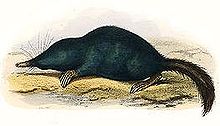| Urotrichini | |
|---|---|

| |
| Himizu, or Japanese shrew mole (Urotrichus talpoides) | |
| Scientific classification | |
| Domain: | Eukaryota |
| Kingdom: | Animalia |
| Phylum: | Chordata |
| Class: | Mammalia |
| Order: | Eulipotyphla |
| Family: | Talpidae |
| Subfamily: | Talpinae |
| Tribe: | Urotrichini Dobson, 1883 |
| Genera | |
Urotrichini is a tribe of the mole family, and consists of Japanese and American shrew-moles. They belong to the Old World moles and relatives branch of the mole family (Talpidae). There are only two species, each of which represents its own genus. The name "shrew-moles" refers to their morphological resemblance to shrews, while generally being thought of as "true moles". The species are the Japanese shrew mole,[1] True's shrew mole[2] and American shrew mole.[3][4][5][6][7][8]
In Japan, the word "Himizu" (ヒミズ) may refer to both to the Japanese shrew mole in particular and Urotrichini in general; when True's shrew mole is distinguished from the general Himizu forms, the feminine diminutive word "Hime" is added to refer to the smaller size of that species. Although they are common in Japan, their alpine habitats, small size, and secretive lifestyle makes them generally unknown except among some mountain people and researchers.
- ^ "ハチュウ類・両生類・小型ホニュウ類図鑑". Kagakukan.sendai-c.ed.jp. Retrieved 2013-09-01.
- ^ "Adw: Talpidae: Classification". Animaldiversity.ummz.umich.edu. Retrieved 2013-09-01.
- ^ Yates, Terry L.; Greenbaum, Ira F. (1982). "Biochemical Systematics of North American Moles (Insectivora: Talpidae)". Journal of Mammalogy. 63 (3): 368–374. doi:10.2307/1380433. JSTOR 1380433.
- ^ Yates, TL; Moore, DW (1990). "Speciation and evolution in the family Talpidae (Mammalia: Insectivora)". Prog. Clin. Biol. Res. 335: 1–22. PMID 2408071.
- ^ Nowak, Ronald M; Walker, Ernest Pillsbury (1999-04-07). Walker's Mammals of the World. ISBN 9780801857898. Retrieved 2013-09-01.
- ^ Motokawa, Masaharu (June 2004). "Phylogenetic relationships within the family Talpidae (Mammalia: Insectivora)". Journal of Zoology. 263 (2): 147–157. doi:10.1017/S0952836904004972. ISSN 1469-7998.
- ^ Shinohara, Akio; Suzuki, Hitoshi; Tsuchiya, Kimiyuki; Zhang, Ya-Ping; Luo, Jing; Jiang, Xue-Long; Wang, Ying-Xiang; Campbell, Kevin L. (December 2004). "Evolution and Biogeography of Talpid Moles from Continental East Asia and the Japanese Islands Inferred from Mitochondrial and Nuclear Gene Sequences". Zoological Science. 21 (12): 1177–1185. doi:10.2108/zsj.21.1177. hdl:2115/14745. ISSN 0289-0003. PMID 15613798. S2CID 6905702.
- ^ Carmona, F. David; Motokawa, Masaharu; Tokita, Masayoshi; Tsuchiya, Kimiyuki; Jiménez, Rafael; Sánchez-Villagra, Marcelo R (2007-12-17). "The evolution of female mole ovotestes evidences high plasticity of mammalian gonad development". Journal of Experimental Zoology Part B: Molecular and Developmental Evolution. 310B (3): 259–266. doi:10.1002/jez.b.21209. PMID 18085526.